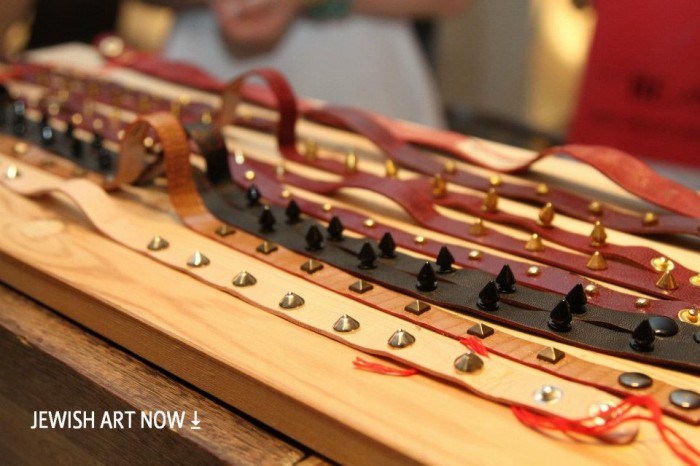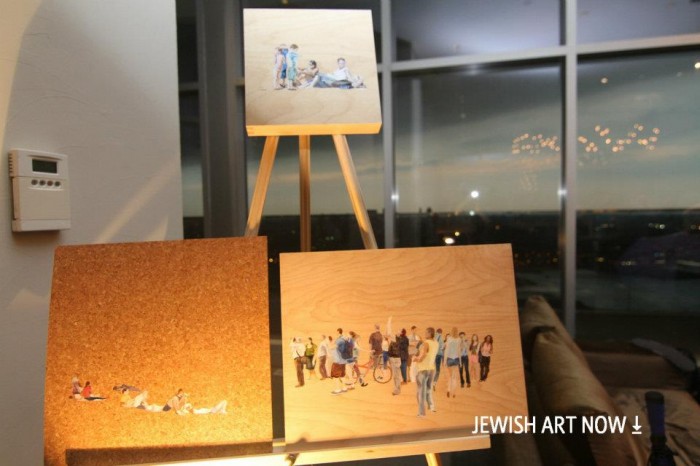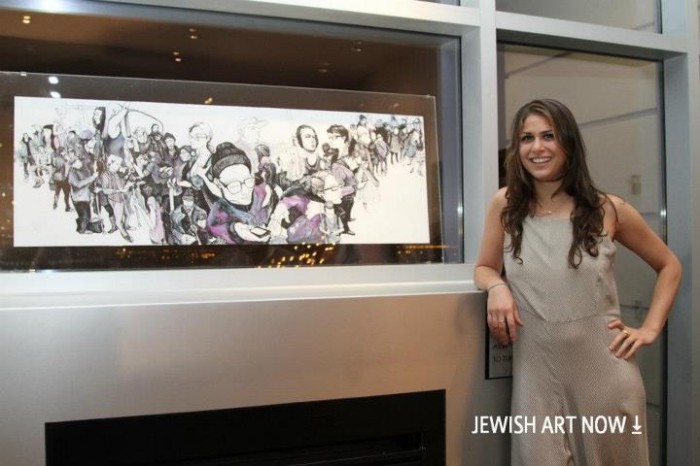Jewish Art Brought Down to Earth at “Sky Gallery”
by Saul Sudin
Perched atop a residential skyscraper in New York City, twelve emerging artists from across the Judeo-religious and geographic landscape shared their work in an engaging event presented by Jewish Art Now and Bridging the Gap. The evening included a full scale exhibition, presentations and demonstrations from the artists, a pop-up shop of unique art ephemera, and interactive umbrella art, open to all attending.
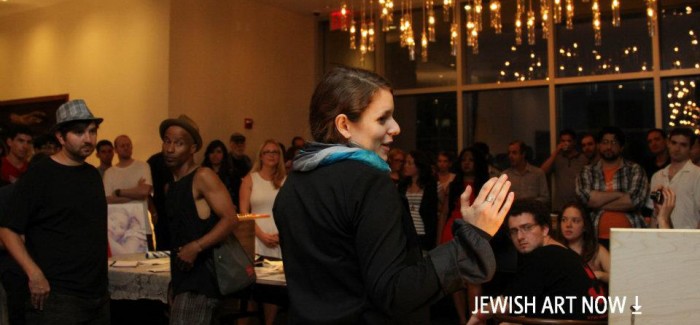

This one night exhibition, titled Sky Gallery for its location in a panoramic rooftop lounge on Wall Street transformed into a gallery space, was curated and produced by Jewish Art Now whose mission it is to promote and innovate contemporary Jewish art around the world. Husband and wife team Saul and Elke Reva Sudin, working artists in their own regard, operate Jewish Art Now and with Sky Gallery they assembled a diverse and passionate group to exhibit, mostly working in two dimensions. Sky Gallery raised funds for this exciting initiative and to support emerging artists working in Jewish themes.
Their co-organizer – Bridging the Gap – is a fellowship that brings together students from different demographics and religious levels to share in experiences and events. They cultivate themselves as a connective tissue between Russian, American and Sephardic communities from a variety of college campuses in New York. Bridging the Gap’s Director Tanya Gutsol took the initiative to spearhead this event because, as she told us, “It is important for students to raise awareness of the arts in Jewish communities, and how it can bring diverse communities together.” Utilizing student volunteers under the direction of Gutsol, this was the first arts and culture fundraiser that the fellows of Bridging the Gap have organized, and the event found itself as unique in location and attendance as it was to the day on which it was held.
Taking place during “The Nine Days”, a time of mourning on the Hebrew calendar that starts at the beginning of the month of Av and ends with the fast day Tisha B’Av, this is historically the saddest time in Judaism. Not usually a time for celebration, there are restrictions in the Orthodox tradition against live music, eating meat, drinking wine, or even taking a hair cut- all things that go with beauty and joy. As such, Sky Gallery featured no music, no alcohol, and to top it off, the 360 degree view of the city was blocked when the skies clouded up into a tumultuous rainstorm outside. The juxtaposition of mourning and celebration set a stage that put an emphasis on thought, exploration, and especially the art itself.
Inside, without the normative distractions of wine and music that usually accompany a gallery show, artists presented their work- and people listened. The artists opened their hearts and told the stories behind themselves and their works, bringing deeper levels of meaning to the engaging works displayed around the room. All of the participating artist are young and just finding themselves and the approach they take to their respective media, but the work on display was indicative of artists who despite their age have forged new voices trying address concepts dear to their hearts.
In the center of the room was a table presenting the work of Cher Landman of Be-Share-Et designs. Cher shared her tefillin inspired bracelets where the wrapped leather, with prayer on the inside, mimics the feeling of being wrapped in the leather straps worn daily by religious Jewish men. Jewish Art Now founder and Creative Director Saul Sudin demonstrated the wrapping of tefillin to show the inspiration for Cher’s bracelets, but hers can be worn by anyone as an inspirational and fashionable item.
Upon entering the space, one could be struck by the paintings of Rutie Borthwick, a visiting artist from London, England. She shared works on wood that illustrate a sea of figures with no background, leaving the viewer to create their own landscape for these people adrift in the world.
Sara Erenthal presented a nude self portrait with a floating head and described her journey growing up in the Ultra-Orthodox Neturei Karta community in Israel, traveling to India, cultivating her creativity, and then working as a figure model in New York. Her painting expresses the discomfort she still feels with exposing her body, based on her upbringing, but the treatment of the figure shows a willingness to overcome creative challenges and cultural ones.
With the most work displayed of any artist in the show, the talented Vitaly Umansky portrayed narrative paintings featuring cats in Jerusalem. Crawling through the old city streets, expressive and individualized, one can understand how the cats, who literally inhabit the city, could also be a metaphor for all the holy land’s residents. He chose to recognize these creatures that are such an integral part of the Jerusalem landscape, and give them their own spotlight, with compositions from the cat’s perspective.
Continuing a thread of middle eastern influence, Rivka Nehorai presented her painting of Iranian President Mahmoud Ahmadinejad, surrounding him with a quote from the Torah spoken by Moses to the Jewish people never to forget what was witnessed at Mt. Sinai. Rivka pointed out that even now, when there are still countless survivors and witnesses living among us, there are powerful people like Ahmadinejad who deny the existence of the Holocaust.
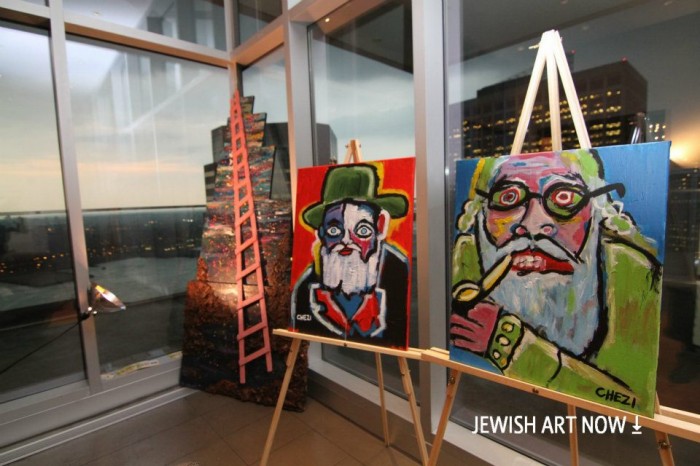

Bess Rappel exhibited her two-dimensional sculpture titled “Jacob’s Ladder”. Using extreme foreshortening and iridescent paint. Bess uses the ladder as a transition from the physical realm to the spiritual realm, much like the one in Jacob’s dream. Her work was extremely powerful against the windows of the rooftop space where sculpture fell into shadow, merging with the city skyline in the background.
Chezi Gerin’s work portrays Chassidic rabbis in a very closeup composition, with an abstract expressionate style and bold bold colors that are almost cartoonish in approach. The artist spoke of how before coming to New York he always saw these Rabbinic figures as being very black and white, and upon learning more, saw how rich and vibrant the Chassidic masters are. As a result, he decided to paint them with less regard for reality as most Chassidic paintings do, and move into colorful meditations on the spirit of the person.
Illustrator Ariana Nehmad draws people live on the subway, than reworks the drawings in her studio into complex compositions. Like Rutie, Ariana uses the figures themselves to create a landscape, using specified line quality and pushing and pulling figures to create a three dimensional space on a two dimensional surface. The wide-angle, landscape oriented length of the piece is evocative of the trains from which she takes her inspiration.
Finally, Valentina Loseva works in large expressionate paintings, a smaller one of which was on display that evening. She sat side by side with Rufina Gilkarov’s linocut print on a wood panel portraying a scene of worship. The Minute detail of the monochrome linocut was in direct juxtaposition of the larger and colorful abstract work. Gilkarov evokes a quality and craftsmanship not seen much anymore, which is an interesting meditation on the content of the figure in prayer depicted. While linocuts were traditionally used for commercial purposes, here she gives it energy through positive and negative impressions, making a statement about the oneness of it all.
This event was not significant for its inclusionary relaxed structure or amazing views of New York City, but because its showed art for arts sake within a Jewish context. Formal visual elements were discussed on high and brought down to the people, reflecting Judaism’s mosaic Torah in this inspirational Sky Gallery.
If you would like to help facilitate more Jewish art events in your community, contact Elke at ersudin@jewishartnow.com
To view the full gallery of images from the event, visit the Exhibition Flickr page.
